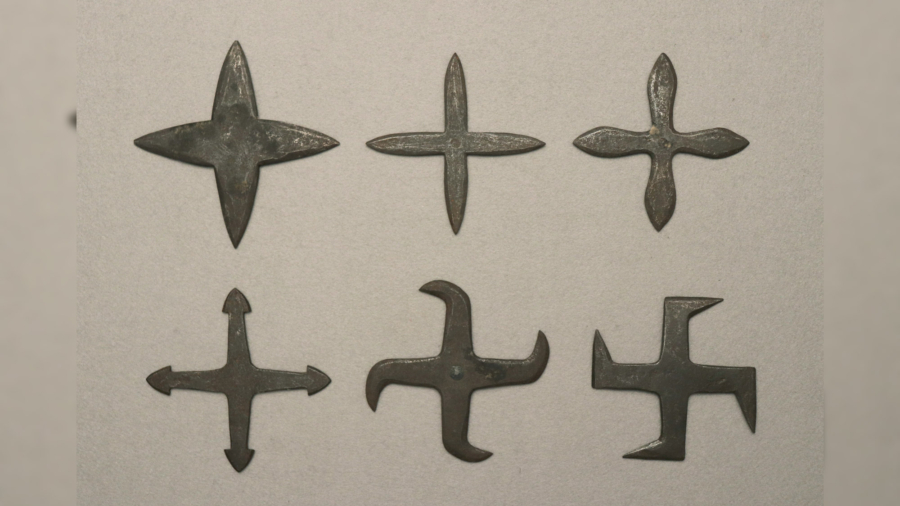The flattened stones and spiky clay balls had languished in two Japanese museum collections for decades.
But when Akihiro Iwata came across them in 2019, the Japanese archeologist and curator was sure he’d made a “ground-breaking discovery.”
He was convinced he’d found very early ninja throwing stars, or shuriken, used by the mysterious covert agents of feudal Japan as throwing weapons.
“I’d always been on the hunt for ninja weapons from the Sengoku period or “era of warring states” (1467 to 1615) so I was relieved when I finally found them,” said Iwata, an archaeologist and curator at the Saitama Prefectural Ranzan Historical Museum outside of Tokyo.
Known for their secrecy and high levels of skill, ninjas were masters of espionage, sabotage, assassination, and guerrilla warfare dating back to at least to the 14th century.
Iwata is scheduled to publish a book on his discoveries in March after the 430-year-old weapons were exhibited last summer.
All the artifacts were excavated in archaeological sites in Saitama and Hachioji, a city in the western part of Greater Tokyo, between 1920 and 2010 and held in two museum collections in those cities.
He told CNN that the flat green stones with sharp corners found at the ruins of the Iwatsuki castle and the Owada jin’ya administrative headquarters in Saitama were likely prototype throwing stars. And the baked clay balls found at Hachioji castle are likely “makibishi” or caltrops—which can injure the feet of enemy soldiers and horses when laid or thrown onto the ground.
“I knew they were ninja weapons because the structure was so similar to weapons found in the Edo period (1603 to 1867),” said Iwata in a phone interview. However, those weapons were made of steel not stone.
Siege of Odawara
Ninja emerged around the end of the Kamakura Period (1192 to 1333) when feudal lords in Japan started hiring rogue warriors as mercenaries, according to Yuji Yamada, a humanities professor and vice president of Mie University’s International Ninja Research Center.
Yamada, who was not directly involved in the research, said he agreed with Iwata’s assessment that the artifacts were prototype ninja stars and caltrops.
“Those mercenaries served under the feudal lords as spies and scouts who gained intel on enemies,” said Yamada.
During the Edo period (1603 to 1867), they continued to work as spies and as gatekeepers maintaining public order in castle towns and acted as bodyguards to important figures, said Yamada, who noted that most ninja weapons discovered dated to this era.
Iwata said that the possible ninja artifacts date to the Siege of Odawara, which took place in 1590 in what is now Saitama prefecture, during the era of warring states.
The period saw hundreds of strongmen from mini-states across the country vying for power. In the siege of Odawara, the Toyotomi and Tokugawa clans battled the Hojo clan—one of the most powerful in Japan at the time.
Four unglazed clay balls were among items excavated at the ruins of Hachioji Castle around 1960, said Iwata. Each ball, measuring roughly 1 to 3 cm (0.4 to 1.2 inches) in diameter, has four spiky projections.
Iwata explained that the artifacts were likely the weapons of a group of low-ranking warriors who moved into action as ninja to defend the castle against the enemy attack at Hachioji. Some were likely made in a rush as they appear imperfect, he added.
“They threw the stones and shuriken at them to slow the enemy’s progress, and get away,” he said.
But despite their best efforts, the Toyotomi and Tokugawa clans defeated the Hojo clan and captured both Iwatsuki and Hachioji castles.
“A lot of things were left behind because Toyotomi’s army attacked and set fire to the castles after it fell during the Odawara invasion. The items found are evidence of the castles’ fall,” said Iwata.
Iwata said his observations were likely only the tip of the iceberg, with many other undocumented ninja artifacts hiding in museum collections.
“It made me think that there’s a whole treasure trove of ninja weapons out there, waiting to be discovered,” said Iwata.


